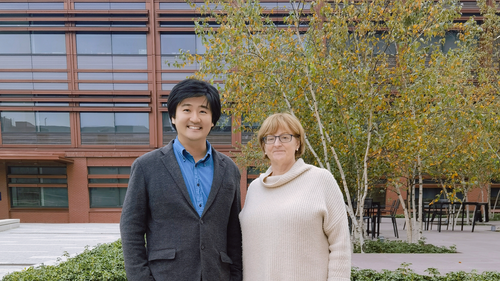
On November 2, 2023, Chuan Tian, successfully defended the thesis, “Deciphering the Trigger of Luminous AGNs through the Lens of Artificial Neural Networks” (advisor: Meg Urry).
Tian explained, “Supermassive blackholes (SMBH) are found at the center of nearly all large galaxies. Yet, only a small fraction of them is active — in which case the “active galactic nucleus” (AGN) can emit powerful radiation, provided there is a fueling supply that allows continuous matter accretion onto its surface. Such fueling mechanism necessitates several triggering modes, depended on the rate of matter accretion (which is indicated by the AGN’s full band X-ray luminosity): while less luminous AGNs can be fueled by a slow, secular process, more luminous AGNs need a galactic-wide turbulence (to bring a sufficient amount of mass towards the galactic center), which can likely happen in a violent event where two gas-rich galaxies of comparable mass collide and merge with each other (“wet major merger”). To study whether merging events give birth to luminous AGNs, one may look at the morphology of the AGN host galaxy, which indicates whether the host galaxy has undergone a recent merger or not. Unfortunately, many previous studies missed a substantial fraction of luminous AGNs (the lack of high luminosity), and/or only carried out in the local universe (the lack of high redshift), and analyzed only a limited number of AGN candidates (the lack of large sample size). Using a composite machine learning framework and high-quality images from the Hyper Supreme-Cam wide survey, my thesis research captures about an order of magnitude more sources than previous studies in the large-area Stripe 82X survey (AGNs in this sample are systematically brighter). Machine learning models developed in my thesis research are publicly accessible on the Internet — to further shed light on the mysterious link between mergers and high luminous AGNs, they can be easily re-trained via transfer learning on several incoming surveys, as this approach is only subject to data quality and computational power at hand.”
Tian continues, “I am currently deciding on my future career options.”
Thesis Abstract:
For decades, it remains an open question of how active galactic nuclei (AGNs) are triggered and fueled. As continuous emission at enormous rate across a wide spectrum requires an efficient mechanism of fueling, AGNs can also shut off the fuel supply and ultimately deactivate themselves. Consequently, the most plausible scenario in which AGNs are triggered is when morphological disturbance is present, namely in merger events between two comparable gas-rich galaxies. Although AGNs can also be fueled in less violent secular processes, major mergers are believed as a promising method especially for triggering the most luminous AGNs.
The merging history of AGN host galaxies can be traced by their morphology. However, accurately determining host galaxy morphologies of bright AGNs has been a nontrivial task for traditional light profile fitting methods. In this thesis, we first invoke a generative adversarial network, PSFGAN, to decompose the bright AGN point source from their host galaxy light. These recovered host galaxies can then be analyzed by discriminative models to classify them as disk-dominated, indeterminate and bulge-dominated (GaMorNet) or to predict probability distributions of their bulge-to-total ratio, effective radius and flux (GaMPEN). Using galaxy images within redshift z~1 and magnitude m<23 from all five bands of the Hyper Supreme-Cam (HSC) Wide survey, we demonstrate these machine learning frameworks can be trained as linked pairs (PSFGAN + GaMorNet or GaMPEN) to yield accurate predictions that agree well with traditional methods yet in the meantime be orders of magnitude faster and provide AGN host information in a greater detail. Our final models can also be easily fine-tuned via transfer learning for other incoming surveys for efficient analysis of AGN host galaxy morphologies.
To shed light on the controversial question of how bright AGNs are triggered, we apply our final models on a sample of ~1,500 real X-ray-selected AGN candidates with full band LX between 1041 and 1045 erg/s at 0 < z < 1.0 within the Stripe 82X field that overlaps with the HSC Wide footprint. A detailed analysis on the color-mass diagrams by AGN host morphology and X-ray luminosity reveals several key findings of AGN evolution with their host galaxies: For less luminous AGNs (LX < 1043), disk-dominated hosts are prevalent from the blue cloud to the red sequence, indicating a slow quenching mode driven by secular processes in their hosts. On another hand, bulge-dominated hosts mostly live in the red sequence and their presence in the blue cloud & green valley are rarer, supporting the hypothesis that they are triggered by galaxy mergers. The distribution of AGN hosts is reshaped for moderate luminous AGNs (1043 < LX < 1044), in which region AGNs reside in all color and mass ranges regardless of morphological type and a substantial fraction of them reside in star-forming galaxies. Within this luminosity interval, disk hosts are indicative that mergers cannot be the only trigger of AGNs, while bulge hosts may indicate it takes longer to quench star formation in recently merged remnants (likely of bulge morphology) and this quenching period is comparable to the lifetime of their AGNs. At last, for high luminous AGNs (LX > 1044), there are much fewer disks than bulges, consistent with mergers triggering the most luminous AGNs.